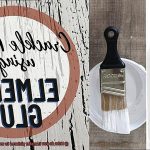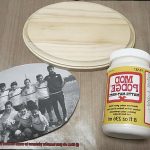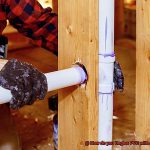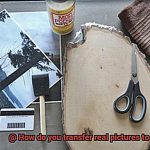Brick walls are a sight to behold – rugged, raw and robust. They exude an aura of strength and durability that’s hard to match. But let’s be honest, trying to attach something to a brick wall can be a real pain in the neck. Fear not though, because we’re here to help you master the art of adhesive application. So if you’ve been wondering “how do you stick something to brick?”, then keep reading.
Whether it’s adding some pizzazz to your brick wall with a statement artwork or embarking on a DIY project around your home, knowing how to attach objects effectively is essential.
Thankfully, there are plenty of ways to get the job done right. From traditional nails and screws to modern adhesives, each method has its own unique benefits and drawbacks. But before you go all-in with your chosen method, there are some key factors you need to consider such as the weight of the object, type of brick and weather conditions.
In this blog post, we’ll delve into different techniques for sticking items onto brick walls. We’ll provide expert advice on which materials work best for specific applications so that you can get the job done like a pro. So sit tight and get ready for some adhesive awesomeness.
What to Consider When Sticking Something to Brick?
Contents
When it comes to sticking something to brick, it’s important to consider a few key factors before reaching for any adhesive. Here are five sub-sections to keep in mind when choosing the right adhesive for your project.
- Surface Texture: The texture of the brick surface is an important factor to consider when choosing an adhesive. Smooth, non-porous bricks may require a strong adhesive like epoxy or construction adhesive, while rough or porous bricks may require a masonry adhesive or mortar. It’s essential to choose an adhesive that can create a strong bond on the surface texture of your brick.
- Weight and Size: The weight and size of the item you want to stick to the brick is another critical consideration. A heavier object will require a stronger adhesive or mounting hardware to ensure it stays in place. It’s essential to choose an adhesive or fastener that can support the weight and size of your object.
- Temperature and Moisture: Temperature and moisture can impact how well an adhesive sticks to brick. Extreme temperatures or moisture can cause some adhesives to break down or lose their effectiveness. It’s crucial to select an adhesive that’s designed for outdoor use if your item will be exposed to the elements.
- Environmental Factors: If your item will be exposed to direct sunlight or other environmental factors that may cause fading or discoloration, choose an adhesive that is specifically designed for outdoor use. It’s essential to take into account any environmental factors that may affect the effectiveness of the adhesive over time.
- Location on Brick Surface: Consider the location of the item on the brick surface when selecting an adhesive. If it’s in a high-traffic area or exposed to wear and tear over time, you’ll need an adhesive that can withstand these conditions. Additionally, if you’re attaching something to a painted or stained brick surface, be sure to choose an adhesive that won’t damage or discolor the finish.
In conclusion, choosing the right adhesive for sticking something to brick requires careful consideration of the surface texture, weight and size of the item, temperature and moisture, environmental factors, and location on the brick surface.
Using Epoxy Adhesive
This exceptional adhesive is a popular choice for bonding objects to brick due to its strength and versatility.
Before diving in, it’s important to properly clean and prepare the brick surface. Using a wire brush, remove any loose particles or debris and allow the surface to dry completely before applying the adhesive. This ensures that the adhesive will have a proper surface to bond with.
Mix together the two components of the epoxy adhesive – the resin and hardener – and apply a small amount onto the surface of the object you wish to bond. Press the object firmly onto the brick surface and hold it in place for several minutes until the adhesive sets. Keep in mind that epoxy adhesive can take several hours or even overnight to fully cure, so be patient.
One of the great things about using epoxy adhesive is that it can be used on both porous and non-porous surfaces. This means you can bond a variety of materials to your brick walls, such as metal, wood, and plastic. The possibilities are endless.
However, it’s crucial to use caution when working with epoxy adhesive. It can be toxic if ingested or if it comes into contact with skin or eyes. Be sure to read and follow all safety precautions listed on the packaging before use.
Using Construction Adhesive
This heavy-duty glue is specifically designed for bonding applications, making it the perfect solution for attaching objects to brick walls.
Before applying the adhesive, it’s crucial to ensure that the surface of the brick is clean and dry. Any dirt or debris can prevent the adhesive from bonding properly. Take a wire brush or sandpaper to any stubborn stains or residue to ensure a smooth surface.
Once the surface is prepped and ready, apply small dots or lines of construction adhesive on the back of the object that needs to be attached to the brick. Be careful not to apply too much adhesive, as this can create a messy appearance.
Now it’s time to press the object firmly onto the surface of the brick. Hold it in place for several minutes, allowing the adhesive to set and bond properly. This will ensure that your object stays securely attached for the long haul.
When choosing a construction adhesive, make sure to choose a high-quality one that is specifically designed for this application. Follow the instructions carefully for best results.
Using Double-Sided Mounting Tape
Say hello to double-sided mounting tape – your new best friend in the world of hassle-free wall decorating. As an expert on using double-sided mounting tape, I’m here to guide you through the process and ensure your objects stay put.
First things first, not all tapes are created equal. When selecting a tape, make sure to choose one that is designed for outdoor use and can withstand extreme temperatures and weather conditions. You don’t want your objects falling off during the next storm.
Before applying the tape, ensure that the brick surface is clean and dry. A dirty surface can weaken the bond of the tape, so grab a damp cloth and wipe down the area where you plan to stick your object. Now that your surface is prepped, cut the tape to the desired length and apply it to the back of your object.
The moment has arrived – it’s time to stick your object to the brick. Press firmly for at least 30 seconds to ensure a strong hold. For additional reinforcement, consider using a clamp or heavy object to hold it in place for at least 24 hours.
It’s important to know that double-sided mounting tape is best suited for small and lightweight objects. For larger or heavier items, consider using anchors or screws for a stronger and more secure hold.
Tips for a Strong Bond
When it comes to sticking something to brick, a strong and durable bond is essential. Here are five steps to follow for achieving a secure bond:
Step 1: Clean the surface
Before applying any adhesive, ensure that the surface of the brick is thoroughly cleaned and free of debris. Use a wire brush or scraper to remove loose materials, and wipe the surface with a damp cloth to get rid of any dust or dirt. This step will help the adhesive stick properly and create a strong bond.
Step 2: Choose the right adhesive
Choosing the right adhesive is critical for creating a strong bond. There are various types of adhesives available, so it’s important to select one that is suitable for sticking to brick. Whether you go for construction adhesive, epoxy, or silicone adhesive, it’s essential to choose one that is best suited for your project.
Step 3: Apply the adhesive evenly
When applying the adhesive, be sure to follow the manufacturer’s instructions carefully. Spread the adhesive evenly over the surface of the brick using a trowel or putty knife. This will help ensure that there are no air pockets or gaps between the brick and the object being attached.
Step 4: Use clamps or weights
Depending on what you’re trying to stick to the brick, you may need to use clamps or weights to hold it in place while the adhesive dries. This will help ensure a strong bond and prevent the object from shifting or falling off.

Step 5: Allow time for curing
Once you have applied the adhesive, you need to allow time for it to cure fully before adding any weight or stress to the bond. The curing time will vary depending on the type of adhesive used, so be sure to follow the manufacturer’s instructions carefully. Remember to be patient and allow ample time for the adhesive to dry completely before using or moving the object.
Dangers of Improperly Attaching Objects to Brick
Attaching objects to brick walls and surfaces can be a tricky task, and if done improperly, it can lead to dangerous consequences. In fact, it’s not just a matter of aesthetics – improperly attached objects can fall and cause injuries or property damage. Let’s dive deeper into the dangers of improper attachment and how to avoid them.
Firstly, one of the biggest concerns with improper attachment is the risk of damaging the brick itself. This can happen if you use the wrong type of adhesive or drill into the wrong part of the brick. The result? Permanent damage to the surface that not only looks unsightly, but also weakens the structure of the wall – especially alarming if the wall is load-bearing.
But that’s not all. Improper attachment can also lead to water damage by creating holes or gaps in the brick that allow moisture to seep in. The potential for water damage is especially concerning when considering outdoor attachments that are exposed to sunlight and other elements, which can cause materials to deteriorate over time.
Moreover, improper attachment can also pose a fire hazard. If an object is attached too close to a heat source or using flammable materials that are easily combustible, it increases the risk of a fire starting.
To ensure safe attachment, it’s imperative to take the time to properly attach objects to brick walls and surfaces. This involves using the right materials and following manufacturer guidelines. Consulting with a professional is always helpful if you’re unsure about the process.
Maintenance and Care for Attached Objects
Before going ahead, it’s crucial to consider the maintenance and care of the object being attached. Whether it’s a picture frame, a mirror, or a shelf, ensuring that it is properly secured and maintained will prolong its lifespan.
One of the most critical factors to consider when attaching objects to brick is the type of adhesive used. Not all adhesives are created equal, and it’s essential to choose one that is suitable for your specific object and environment. If you’re planning to attach an object outdoors, make sure to use a waterproof and weather-resistant adhesive to prevent any damage from the elements.
Next, prepare your brick surface for attachment. A clean and smooth surface is crucial for proper attachment. Use a wire brush or sandpaper to remove any rough spots or debris before attaching your object.
But what happens after you attach the object? Regular maintenance is key to ensuring its longevity and safety. Here are some tips:
- For shelves, regularly wipe them down and check for any loose screws or brackets that could cause accidents.
- For picture frames or mirrors, dust them regularly with a soft cloth or feather duster.
- For any objects attached with suction cups, reapply them every few months to ensure they haven’t lost suction power.
P6tgrlsX4QM” >
Conclusion
Sticking objects to brick walls might seem like a challenging task, but with the right adhesive and preparation, it can be accomplished safely and effectively. Before attaching anything to a brick surface, consider critical factors such as weight, size, texture, temperature, moisture, environmental conditions, and location on the wall.
Different adhesives are suitable for different applications. Epoxy adhesive is ideal for bonding objects to both porous and non-porous surfaces while construction adhesive works best for heavy-duty bonding applications. For small and lightweight objects, double-sided mounting tape is an easy-to-use option.
However, caution must be taken when working with adhesives as they can be toxic if ingested or come into contact with skin or eyes. Proper cleaning and preparation of the brick surface are crucial before applying any adhesive. Additionally, regular maintenance is essential to ensure the longevity and safety of attached objects.
Improper attachment can lead to disastrous consequences such as damaging the brick itself, causing water damage or posing a fire hazard. To avoid these risks, it’s imperative to use appropriate materials and follow manufacturer guidelines when attaching objects to brick walls.
In conclusion, sticking something to a brick wall requires careful consideration of various factors such as weight and surface texture. By using the right adhesive and following proper preparation procedures, you can attach items safely without damaging your wall or putting yourself at risk.






